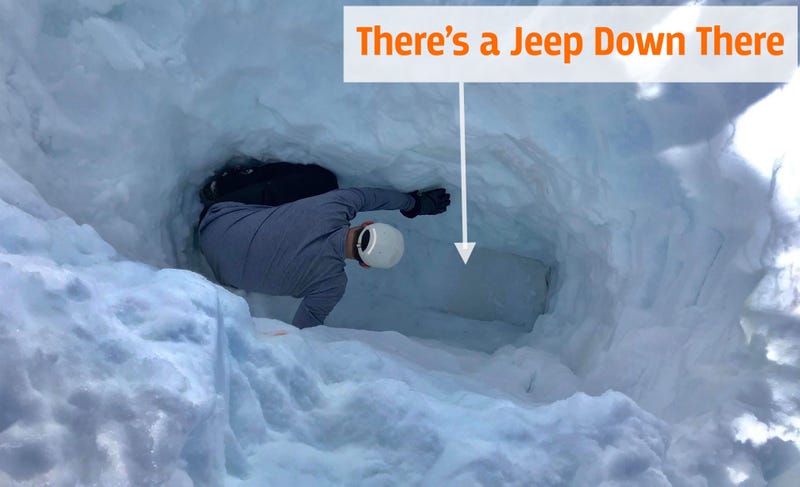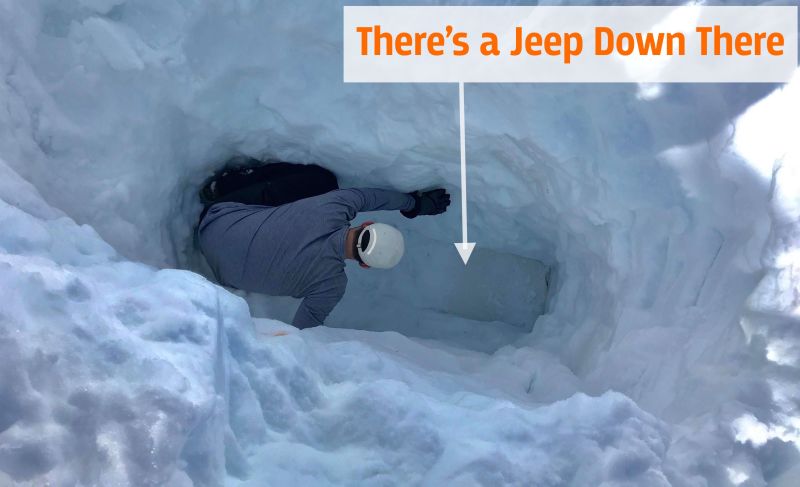
A Tesla engineer bought a gorgeous 2000 Jeep Cherokee in November, but before he could spend much time enjoying it, he got stuck in snow near Lake Tahoe. Within an hour, a blizzard hit, preventing tow companies from helping, so the engineer left the XJ for four months to be crushed by 10 feet of snow. The Jeep sits in the same spot today; here’s a look at the damage.
Deep snow in California’s Sierra Nevada Mountain range has claimed countless victims over the years, from members of the Donner Party in 1847 to a poor pre-‘97 Jeep Cherokee in 2017. Now there may be a second Jeep XJ entering the great junkyard in the sky thanks to the Lake Tahoe region’s unrelenting snowfall, and that’s a darn shame because the Jeep was a beauty.

It’s a 2000 Jeep Cherokee, meaning it’s the first year with a distributorless ignition system, though the anonymous engineer probably didn’t care much about that when he bought it; he told me over email that he chose the year because it—like all 1997 to 2001 Cherokees—came with a passenger-side airbag. For some, that’s an important feature in a daily driver.
The diehard Jalopnik reader had purchased the boxy AMC-designed machine for its lovely character and its “ability to get to remote trailheads,” as he enjoys backpacking in the Sierras.
Advertisement
Back in January, during a ski trip at a cabin near lake Tahoe, he took the Over 200,000 Mile But You Wouldn’t Know It Jeep on an unplowed asphalt road with roughly two feet of what—after a bit of testing with a few stomps of his feet—felt like compacted snow.
Apparently it wasn’t actually entirely compacted, because eventually the Jeep’s front tires sank into some soft stuff, for which even the Jeep’s rugged four-wheel drive system was no match. This happened just as heavy snow began dumping from the skies, leaving the new XJ owner—who acknowledges that driving down this snow-covered road alone wasn’t the smartest move—with no choice but to ditch his beloved white chariot.

Advertisement
“I couldn’t recover it and had to abandon it,” he told me via email, “while Tahoe experienced record snow fall (the local measurement was 500+ inches post-entrenchment).”
“No tow service was willing to drive on the packed snow road after the first blizzard hit.” He and his friends jumped into a buddy’s minivan on a nearby road, and departed from the sad scene.
Mr. Tesla Engineer sent me some pictures to illustrate just how quickly things had gotten out of hand. When he had initially gotten stuck at around 11 a.m., things didn’t look so bad, with the Jeep not even up to its front bumper in snow (see above). By the following morning at around 8:30, white fluff had climbed up to the XJ’s seven-slot snout:

Advertisement
And by 2 p.m., giant drifts covered the vast majority of the Jeep’s exterior:


Advertisement
A few months later, in mid-March, the owner of the then-subterranean mobile rectangle and two of his friends grabbed a shovel and went out to search for the inline-six-powered SUV under the snow. This proved rather difficult.
Using the Jeep’s Panic Button, the trio was able to hear the horn, but only faintly. “It sounded like it was a mile away,” the EV engineer told me over the phone. He said he and his friends used photos he’d taken of the stuck Jeep to try to triangulate the vehicle’s location. Then they resorted to more primitive measures.
“We actually took some 12-foot PVC sections…we’d kinda like just thrust the PVC section into the ground,” he told me. Numerous times, he and his friends dug holes after the PVC seemed to bottom out, only to find ice instead of an entombed 4×4 legend.
Advertisement
After roughly three hours of disappointment, the team finally hit something hard with a pipe. “We definitely found the car because we really could not stop it,” he told me. So they dug a monstrous hole.

“We measured…the hood to be 10 feet below standing level,” the protagonist told me over the phone. This put the roof roughly seven feet below the surface. The photo at the top of the article and the one above show how deep a hole the engineer and his friends had to dig to reach the XJ back in March.
Advertisement
He ran some basic calculations on how much weight was bearing down on that roof:
I had calculated a (~30ft^2 roof) * (7 ft deep) * (20 lbs/ft^3) = 4200 pounds on the roof. It’s certainly more than the curb weight!
A 2000 Jeep Cherokee only weighs about 3,400 pounds, so flipping an XJ upside down would yield less force on that top than all the snow did. That poor XJ.
Advertisement


This past Saturday, over four months since the mighty Jeep beached itself, the engineer and his friends went back out to visit, and found the roof rack poking out of the snow.
Advertisement

“With some shovels and brushes, we dug it out so we could open the doors, but the plowed road was too far to recover from,” the mechanical engineer told me.

Advertisement
The good news is that the Cherokee started right up after a jump, though it did leak a bit of coolant. Mr. Tesla Engineer told me that, before the trio left, they threw some “DampRid” (basically calcium chloride) into the cabin to act as a desiccant to prevent mold from growing as temperatures rise in the coming weeks. This is a smart move, as there’s already a bit of it growing in the Jeep:

In addition, the Jeep now has a solar cover to reduce in-cabin temperatures that might accelerate mold growth. I am a bit concerned that it might trap moisture and have the opposite effect, but we’ll see:

Advertisement
The main character in this story tells me that there are about six feet of snow in the area where the Jeep has sat since January, and based on projections, he thinks the roads will be mostly clear in the next two or three weeks. That’s when he plans to head to the trail with a U-Haul trailer to finally snag his machine from the jaws of the abominable snowman.

But now here comes the dilemma. All that snow bearing down on the Jeep caused some serious damage. The hood is dented, the windshield is cracked, and most importantly, the roof is crushed.
Advertisement

Here’s a closer look:

Advertisement
Here are some peeks from the inside:


Advertisement
The rear wiper and both side mirrors are also broken, and Mr. Tesla Engineer does have a few concerns about the suspension, saying: “When we were digging it out, there was a moment where the body sprung upwards a couple inches.”
“We were concerned about digging off the roof and hood before the side view mirrors for that exact reason- the car would push upwards and bend the iced-locked mirrors down,” he continued. “Didn’t really, matter, we found them bent!”
The mirrors are relatively cheap and easy to replace, and as far as the suspension, if I had to bet, I’d say it’s totally fine. The major issue is the roof, and that’s what’s leaving this Jeep owner searching for a bit of advice.
Advertisement

“I’m at a loss for what to do next,” he told me. “I’m pretty sure insurance will consider it a salvage, but it seems like there’s a lot of potential. I’m down for a project car,” he continued.
“Should I try to restore it back to original? Angle grind the A/B/C/D pillars off and put a roll-cage on? Accept the insurance buyout?”
Advertisement
Looking at these photos, I agree with the XJ owner that the insurance company will call this totaled. But that’s just because XJs are worthless; as I found out myself, it doesn’t take much to total one. I also noticed in the pics that the pillars look okay, and that the only significant damage appears to be to the hood and roof, the former of which is easily replaceable.
As for the roof panel: I think this should be replaceable depending up on the extent of the damage, but in any case, it won’t be easy. Here’s a look at my Jeep Cherokee’s roof panel from the top:
Notice how flimsy that is—it’s no wonder the snow crushed it. Still, while replacing a floppy bit of sheetmetal shouldn’t be hard (and indeed, early XJ roof panels are available for purchase—I’m not sure how it differs from a later one), my concern lies with the cross-car roof supports that, looking at the damage, were almost certainly bent.
Advertisement
Below is a close look at those supports in a 1989 Jeep Cherokee. (A 2000 Cherokee like the one we’re talking about has similar supports as shown here).
What I’d recommend the engineer do is remove the headliner, and assess the roof damage from below. The panel is toast, and those crossmembers are, too. But what about the body sides? If the doors open and close easily, then that’s a good sign.
Advertisement
If just the roof panel and crossmembers were affected, and Mr. Tesla Engineer goes in recognizing that he’s working on a safety-critical part and that he may reduced the overall roof strength of the vehicle (with his background, it’s certain that he realizes this), then perhaps the Jeep can be saved. I think it’s possible.
I’d spend an afternoon at a junkyard with a sawzall and a few spare batteries, and snag an XJ roof panel and some crossmembers. Then I’d get ready to cut up the white Jeep and stitch it back together with a welder.

Advertisement
Again, we’re dealing with the roof of a unibody vehicle, so the quality of the repair is important, as the entire vehicle’s torsional and bending characteristics rely on that lid. But this engineer seems excited to tackle a new project, so, depending upon how the damage looks from the inside, I say give it a try.
Worst case, just buy another clean XJ—perhaps one with a blown motor and bad interior—for dirt cheap, and swap parts over.













